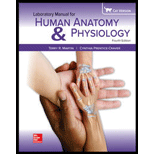
Introduction :
Breathing is controlled from regions of the brainstem respiratory centers, which control both inspiration and expiration. These areas initiate and regulate nerve impulses that travel to various muscles of breathing.
Answer to Problem 1PL
Correct answer :
The correct answer is option (d) Pineal gland.
Explanation of Solution
Explanation/justification for the correct answer :
Option (d) Pineal gland.Pineal gland is a small conical endocrine gland that arises from the roof of the third ventricle of the brain. It produces melatonin and serotonin and may be involved in mood and timing the onset of puberty.So, the correct answer is option (d).
Explanation for incorrect answer :
Option (a) Brainstem. Breathing is controlled at two levels; conscious and unconscious. The autonomic, unconscious cycle of breathing is controlled by brainstem respiratory centers, such as the ventral respiratory group, dorsal respiratory group and pontine respiratory group.So, this is an incorrect option.
Option (b) Pons. Pontine respiratory group is present in pons.Neurons in the pons compose the pneumotaxic center. Input to the pneumotaxic center includes the cerebral cortex are conducted to the dorsal respiratory group and the ventral respiratory group and the respiratory rhythm gets modified. So, this is an incorrect answer.
Option (c) Medulla oblongata.The ventral respiratory group and the dorsal respiratory group which control the autonomic, unconscious cycle of breathing is present in medulla oblongata.So, this is an incorrect answer.
Want to see more full solutions like this?
Chapter 53 Solutions
Laboratory Manual for Human Anatomy & Physiology (Cat Version)
- students in a science class investiged the conditions under which corn seeds would germinate most successfully. BAsed on the results which of these factors appears most important for successful corn seed germination.arrow_forwardI want to write the given physician orders in the kardex formarrow_forwardAmino Acid Coclow TABle 3' Gly Phe Leu (G) (F) (L) 3- Val (V) Arg (R) Ser (S) Ala (A) Lys (K) CAG G Glu Asp (E) (D) Ser (S) CCCAGUCAGUCAGUCAG 0204 C U A G C Asn (N) G 4 A AGU C GU (5) AC C UGA A G5 C CUGACUGACUGACUGAC Thr (T) Met (M) lle £€ (1) U 4 G Tyr Σε (Y) U Cys (C) C A G Trp (W) 3' U C A Leu בוט His Pro (P) ££ (H) Gin (Q) Arg 흐름 (R) (L) Start Stop 8. Transcription and Translation Practice: (Video 10-1 and 10-2) A. Below is the sense strand of a DNA gene. Using the sense strand, create the antisense DNA strand and label the 5' and 3' ends. B. Use the antisense strand that you create in part A as a template to create the mRNA transcript of the gene and label the 5' and 3' ends. C. Translate the mRNA you produced in part B into the polypeptide sequence making sure to follow all the rules of translation. 5'-AGCATGACTAATAGTTGTTGAGCTGTC-3' (sense strand) 4arrow_forward
- What is the structure and function of Eukaryotic cells, including their organelles? How are Eukaryotic cells different than Prokaryotic cells, in terms of evolution which form of the cell might have came first? How do Eukaryotic cells become malignant (cancerous)?arrow_forwardWhat are the roles of DNA and proteins inside of the cell? What are the building blocks or molecular components of the DNA and proteins? How are proteins produced within the cell? What connection is there between DNA, proteins, and the cell cycle? What is the relationship between DNA, proteins, and Cancer?arrow_forwardWhy cells go through various types of cell division and how eukaryotic cells control cell growth through the cell cycle control system?arrow_forward
- Basic Clinical Lab Competencies for Respiratory C...NursingISBN:9781285244662Author:WhitePublisher:Cengage
 Fundamentals of Sectional Anatomy: An Imaging App...BiologyISBN:9781133960867Author:Denise L. LazoPublisher:Cengage Learning
Fundamentals of Sectional Anatomy: An Imaging App...BiologyISBN:9781133960867Author:Denise L. LazoPublisher:Cengage Learning Comprehensive Medical Assisting: Administrative a...NursingISBN:9781305964792Author:Wilburta Q. Lindh, Carol D. Tamparo, Barbara M. Dahl, Julie Morris, Cindy CorreaPublisher:Cengage Learning
Comprehensive Medical Assisting: Administrative a...NursingISBN:9781305964792Author:Wilburta Q. Lindh, Carol D. Tamparo, Barbara M. Dahl, Julie Morris, Cindy CorreaPublisher:Cengage Learning  Cardiopulmonary Anatomy & PhysiologyBiologyISBN:9781337794909Author:Des Jardins, Terry.Publisher:Cengage Learning,
Cardiopulmonary Anatomy & PhysiologyBiologyISBN:9781337794909Author:Des Jardins, Terry.Publisher:Cengage Learning,





